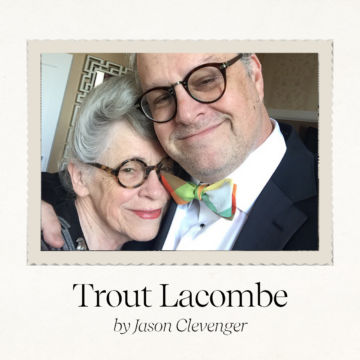 One afternoon I chalked “Trout Lacombe” on the right side of the waiter’s blackboard—the side for the night’s specials. I knew three things about the dish. There would be trout. There would be crawfish tails. And it would be named Trout Lacombe.
One afternoon I chalked “Trout Lacombe” on the right side of the waiter’s blackboard—the side for the night’s specials. I knew three things about the dish. There would be trout. There would be crawfish tails. And it would be named Trout Lacombe.
It was unusual for me to baptize a dish with a proper name. I tended towards simple stylings, like “Shrimp and Squash Bisque”; not quite a brand, more a list of key ingredients. But in this case, I had been inspired by someone—Chris Kerageorgiou, the chef/owner of the transformative La Provence on the North Shore of Lake Pontchartrain near the town of Lacombe.
The problem was I didn’t have a recipe.
You might think that chefs map out new recipes to the last soupçon of salt, then rigorously test and refine before the final dish shows up on the night’s special. As a brash, twenty-something-year-old chef, that was not my jam. Chris had created an au gratin of luscious tails amid bubbling cream and crawfish fat with a whiff of vermouth and a bit of a crunch from seared breadcrumbs. I wanted to take that idea and liven up our prosaic sautéed trout.
A waiter asked what the dish was. I said it had trout and crawfish. He asked how it was prepared. I said he would have to order one to find out. He asked how he should describe it. I said tell the diners it would be good. He scowled. I shrugged.
One of my strengths was cooking à la minute—preparing sauces to order rather than in advance and holding them. I was counting on that strength to come up with something new and delicious, but if all I came up with was trout with crawfish and cream sauce, it would still be pretty yummy.
Not long after we opened, Scowling McWaiter came back to the kitchen and called out for two Trout Lacombes. I put two sauté pans, one large and one small, on the stove and added clarified butter to each—one for the trout and one for the sauce. I started sweating some green onions and mushrooms in the small pan. Then I dredged the trout fillets in egg wash and seasoned corn flour and lowered them into the hot oil sizzling in the large pan.
I added the crawfish tails and their precious fat to the onions and mushrooms, gave the small skillet a flip, and stared down. I would add the cream in a minute. But I needed something distinctive.
I had read that people in Wisconsin were second only to Louisiana in crawfish consumption. I also read that they were first in the nation in brandy consumption. In went a splash of brandy, which made it better, but I felt it still needed a kicker.
In addition to crawfish and brandy, Wisconsin also has Swedes—there is probably a causal connection lurking among those three facts. I recalled (courtesy of the great Time Life series of cookbooks) that Swedish crawfish dishes used dill as the main spice profile.
Into the small skillet went heavy cream and dill; I added a few dashes of Tabasco® for a little bit of acidity (and heat) to counter the richness from the fat. I cranked up the heat to reduce the sauce, flipped the trout, and in a couple of minutes plated the fish and draped the crawfish over the top.
The fat produced a rosy tint to the cream which provided a nice background for the pale green slivers of dill. I added a spoonful of sauce and with a piece of bread to finish the dish and pushed it over to the waiter.
The scowls turned to smiles. A new dish was born.
Be sure to try Jason Clevenger’s recipe for Trout Lacombe.
Photo courtesy JoAnn Clevenger.
